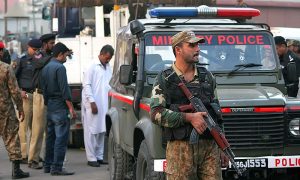Two police officials were killed in Islamabad on June 3. The Tehreek-e-Taliban Pakistan (TTP), a proscribed militant group, has claimed responsibility for the attack.
The TTP’s latest attack targeting security officials in the country’s capital underscores that the group is not only poised to make a comeback, but may have once again established a footprint in Pakistan’s major urban centers. This is not good news as Pakistan attempts to ramp up efforts to contain the group amid the withdrawal of the international troops from Afghanistan.
The TTP has been on the run for years due to Pakistani security forces’ military operation against it. The disintegration of the group’s infrastructure in Pakistan’s tribal areas following the 2014 Zarb-e-Azb military operation and its division into different splinter groups over the last few years has been seen as a win and a durable solution.
However, the first major threat to this assessment came in August last year when the TTP brought two of its major splinter groups back to the fold. The announcement of the merger came only a few days after Pakistan’s Army announced that countrywide military operations against militant groups had brought “hard-earned success.”
Since August 2020, the TTP’s militant activities and presence inside Pakistan have grown significantly. This is happening despite that fact that the once lawless tribal areas where the group had bases before the launch of Operation Zarb-e-Azb are now mostly under the government’s watch.
Over the last few months, the TTP has staged numerous small but targeted attacks on the country’s security agencies. In April, the group carried out a deadly bombing outside a heavily guarded hotel in Balochistan province’s capital, Quetta. The attack was one of the first outside the group’s traditional stronghold, in Pakistan’s northwest region along the border with Afghanistan. In May, the TTP claimed responsibility for two separate attacks on security forces in Khyber Pakhtunkhwa (KP) and Balochistan province, killing at least nine soldiers.
Reportedly, Pakistan’s security agencies have tried to contact the new leadership of the TTP to “start peace talks and put an end to the violence,” but the effort has not produced any meaningful results. If the news is true, then the group may have become a far bigger threat than already known. It is important to note here that the last major attempt on the Pakistani side to negotiate with the Taliban was before the launch of the 2014 military operation.
Meanwhile, Pakistan’s security forces have ramped up efforts to target the TTP’s network in Pakistan and Afghanistan, where the group’s leadership is considered to be based. Last month, a senior commander of the group was killed in Quetta by Pakistan’s security forces. On June 4, Sindh province’s Counter Terrorism Department (CTD) issued a Red Book for the first time in four years, containing names of militant groups and leaders that are a serious security threat. Out of the 93 most wanted names in the Sindh Red Book, at least 23 militants come from the TTP alone. On May 29, another senior commander of the TTP was killed in Afghanistan’s Kunar province near Pakistan’s tribal areas.
As U.S. and other international troops prepare to withdraw from Afghanistan, Pakistan would like to accelerate its targeting of the group’s senior leadership in Afghanistan. The possibility of widespread violence in Afghanistan is imminent once all international troops withdraw. Adding to Pakistan’s worries, U.S. troops are likely to withdraw well ahead of the announced September 11 deadline. There have been several reports of claiming that the withdrawal of U.S. troops from Afghanistan will be complete by July 4.
The rushed withdrawal of U.S. troops from Afghanistan creates plenty of compilations for Pakistan’s ability to target the TTP’s network across the Durand Line, the border dividing both countries. For years, Pakistan has relied on U.S. drone attacks on both sides of the border to target TTP commanders. So far, three former TTP chiefs, namely Baitullah Mehsud, Hakimullah Mehsud, and Maulana Fazlullah, have been killed in US drone strikes. U.S. drone strikes have played a vital role for Pakistan’s security agencies, but at this point, it is unclear what will happen to these operations in the months to come.
The withdrawal of U.S. troops thus raises questions about Pakistan’s ability to target TTP militants in Afghanistan. Does Islamabad have the capability to reach TTP commanders hiding in Afghanistan without relying on U.S. drone strikes?
In the past, Pakistan has quietly offered its air bases for U.S. drone attacks in Afghanistan. Reportedly, Washington has again reached out to Pakistan for a similar understanding. Publicly Islamabad has refused to offer bases, but some analysts say that Pakistan may have again quietly allowed the United States to use its airspace for surveillance operations in Afghanistan. If true, the availability of U.S. drones to target the TTP in Afghanistan would surely be part of the deal. On the other hand, if it’s not true, the TTP would gain a major field advantage in the coming months.
Much will become clear in the coming weeks as far as the US troops presence in the region is concerned. As of now, both the TTP and Pakistan are trying their best to emerge as the beneficiary of the looming uncertainty in Afghanistan.

































